Wood Putty vs Wood Filler (Which to Use & Why)
Scratched wood got you down? Don’t just fill it, fix it right! This straightforward guide explains when to use wood putty vs wood filler and why.
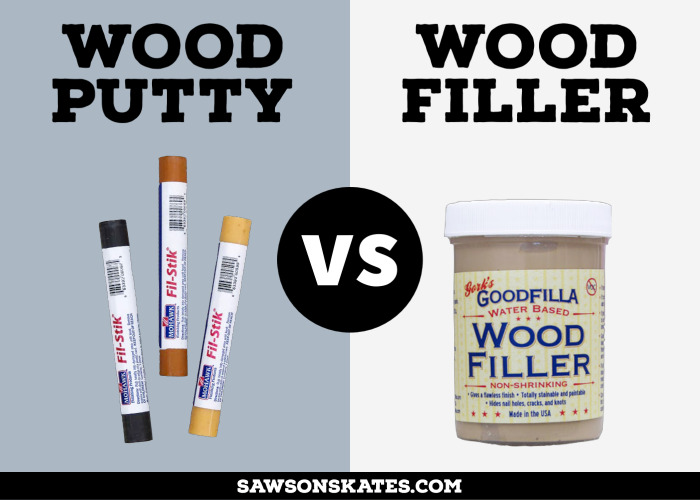
If you’re a DIY enthusiast, you’ve probably heard the terms “wood putty” and “wood filler.” Although they may seem similar, these two products are entirely different and should not be substituted for one another. Understanding their differences will save you time, money, and frustration.
- Which is better for exterior repairs?
- Which one can be stained?
- Which is better for unfinished projects?
In this article, I’ll explain everything you need to know, including what each is used for, the differences between them, and which is the best fit for your project.
Table of Contents
- What is a Wood Putty?
- What is Wood Filler?
- What’s the Difference Between Wood Filler and Wood Putty?
- Wood Filler vs Putty Comparison Chart
- Should I Buy Wood Filler or Wood Putty?
- Frequently Asked Questions
This article contains affiliate links. If you purchase from these links, I may earn a small commission at no additional cost to you. Visit my site policies for more information.
What is Wood Putty?
Wood putty, with its soft, clay-like texture is a lifesaver for mending nicks, gaps, and imperfections. This moldable material, sometimes called “plastic wood,” is usually a blend of plastic and oil-based solvents, like boiled linseed oil. Some formulations even get a boost of strength with calcium carbonate.
However, its chemical composition can damage raw wood, so putty is best suited for touch-ups after your project has been stained and sealed with a top coat, such as polyurethane.
Related: Polycrylic vs Polyurethane: Are They The Same?
Wood putty dries slowly, but instead of hardening, it remains pliable when it’s completely dry. It can be used indoors or outdoors, but its flexibility is excellent for exterior projects.
Wood is affected by seasonal changes in temperature and humidity, causing it to shrink and swell. Because wood putty remains flexible, it expands and contracts along with the wood. Plus, wood putty is weatherproof. It acts as a sealer and is resistant to the effects of the sun and rain.
Related: Mistakes with Wood Can Cause Your DIY Furniture to Crack
Wood putty typically comes in a stick, which is ideal for fixing small holes. For bigger projects, you’ll want a two-part putty that requires mixing with a hardener.
Many wood putty tones are available, such as mahogany, walnut, maple, and oak. You’ll want to choose a putty color that closely matches the stain color of your project for a flawless look.
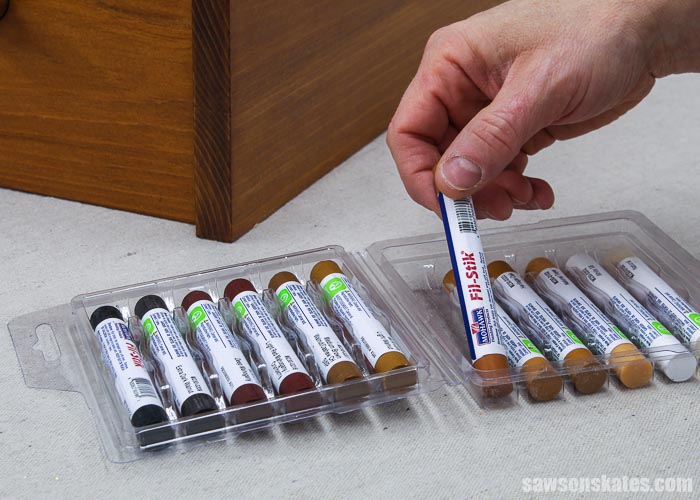
What is Wood Putty Used For?
Wood putty is a versatile product used to hide imperfections on finished surfaces, both inside and outside your home:
- Furniture
- Molding
- Flooring
- Exterior woodwork
From minor blemishes like nicks and scratches to gouges and gaps between joints, putty can tackle it all. It’s also handy for touch-ups, whether hiding those pesky nail holes you missed during your prep work or repairing any areas where wood filler has fallen out.
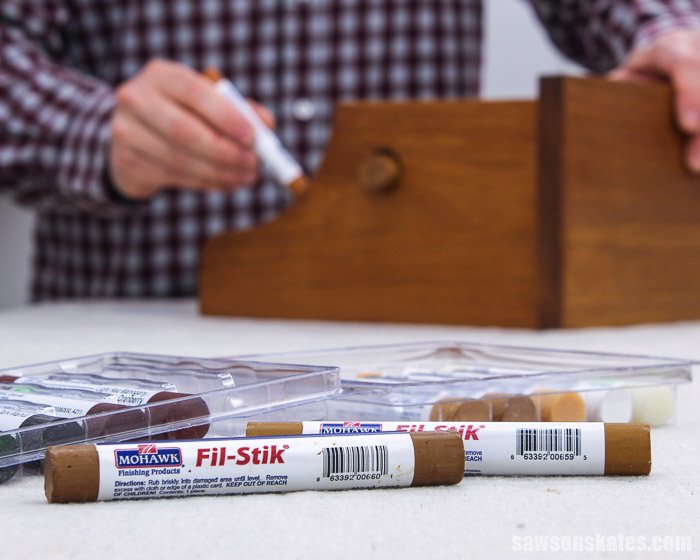
For small cracks in deck boards, wood putty offers a simple fix. However, a two-part hardening putty is the way to deal with wider gaps. This heavy-duty option forms a powerful bond with the wood, effectively stopping the crack from spreading and ensuring a long-lasting repair.
What are the Pros and Cons of Wood Putty?
Let’s summarize the advantages and disadvantages of wood putty now that we know what it is and how it’s commonly used.
Pros
- It can be used on both indoor and outdoor projects.
- It remains pliable, so it can flex with the wood as it moves due to seasonal changes.
- It’s available in different colors to match the stain of your project.
- It can be used for small touch-ups and major repairs.
Cons
- It contains chemicals that can damage raw wood, so it should only be used on finished projects.
- It doesn’t harden as it dries, so it’s not ideal for structural repairs.
How to Use Wood Putty
This quick video shows how easy it is to use wood putty.
What is Wood Filler?
Wood filler, a handy paste-like material, comes to the rescue when you need to fill holes and cracks in raw wood. Typically a water-based mixture, it creates a strong bond with the wood thanks to a blend of binding agents and ingredients like wood fibers, sawdust, cellulose, or gypsum.
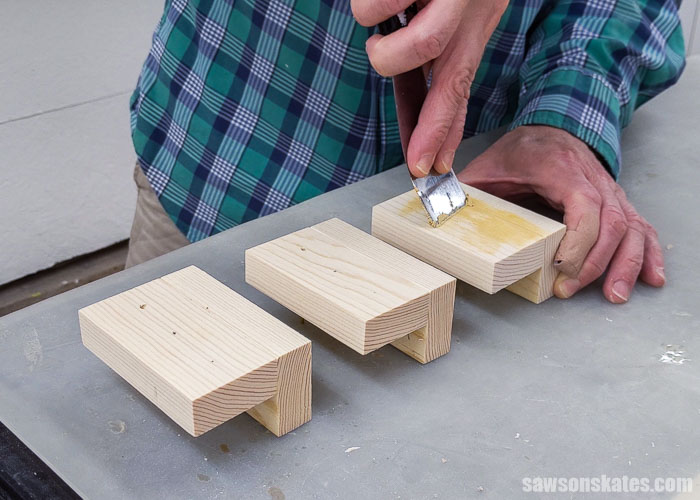
Wood filler dries hard, usually in less than an hour, unlike putty, which remains flexible.
While filler is excellent for repairing indoor projects, it’s not ideal for outdoor applications. Here’s why:
- It can crack: Wood naturally expands and contracts with changes in temperature and humidity. Wood filler dries hard and can’t flex with these movements, which can cause it to crack.
- It’s not weatherproof: Wood filler isn’t designed to withstand the elements. Sun exposure can cause it to shrink and fall out, and rain can wash it away.
However, a few solvent-based wood fillers are designed for outdoor use. We’ll discuss these in the Types of Wood Filler section below.
Applying wood filler:
- Apply slightly raised, then sand smooth.
- Since sanding is required, it’s best for patching raw wood and unfinished projects.
Wood filler is generally available in one neutral color, although it can be purchased in a variety of wood tones, such as walnut, oak, and mahogany.
Some wood fillers are intended to be finished with a coat of paint, while others are labeled as stainable.
Stainable wood fillers are porous, meaning wood stains can penetrate into them, allowing the repair to blend in with the surrounding surface. You can also mix the filler with wood dyes, tints, or sawdust from your project to create an even better color match.
Not all stainable wood fillers are good at absorbing stain, and I tested seven of them in this side-by-side comparison to see which ones perform the best.
Related: Does Stainable Wood Filler Work? (Here’s the Answer)
What is Wood Filler Used For?
Wood filler is frequently used to conceal flaws in raw or unfinished indoor projects, like do-it-yourself furniture and interior woodwork, before applying paint or stain. On the other hand, epoxy fillers are durable enough to withstand outdoor use.
Filler will hide nail holes, small scratches, nicks, and gouges. It also works well for filling large damage like cracks.
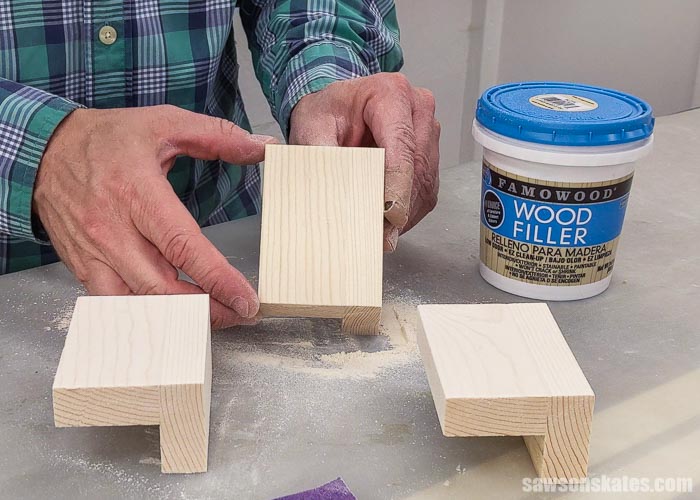
Types of Wood Filler
The two most common types of filler are water-based and solvent-based. Water-based fillers are best suited for indoor uses. Solvent-based fillers like polyurethane and epoxy are more durable and can be used outdoors.
Latex Wood Filler
The most common type of water-based wood filler is latex. Woodworkers often use it to patch interior furniture projects. Some popular brands include Minwax Stainable wood filler and DAP Plastic Wood.
DIY Wood Filler
DIY wood filler is an excellent choice if you plan to stain your project. You’ll use sanding dust to make the filler, which will be a good match since the dust is from the same wood species as your project.
Related: Clever Uses for Sawdust: 11 Ideas That Will Inspire You
To make this wood filler, I collect wood dust from my random orbital sander and mix it with enough dewaxed shellac to make a paste-like consistency.
Related: How to Make a DIY Wood Filler
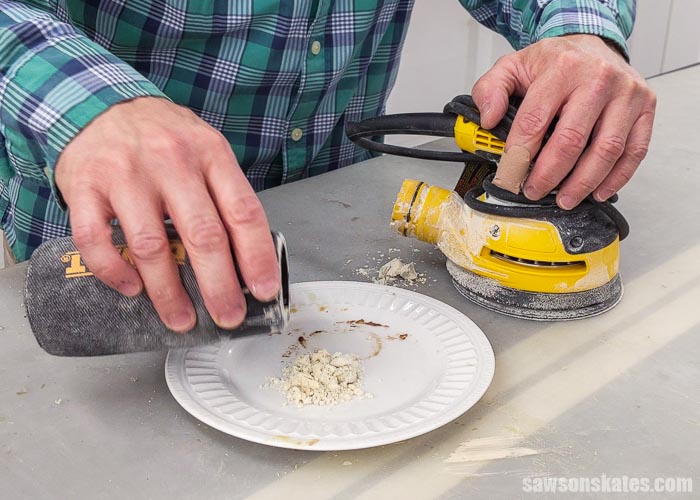
Wood Grain Filler
Open grain woods, such as oak, have large pores. Wood grain filler is made specifically for filling the pores of open-grained woods to produce a smooth finish. It’s often used on projects such as tabletops and countertops.
Epoxy Wood Filler
Epoxy is used to repair rotted wood and restore its original strength and structure. It’s typically used in the renovation and restoration of older homes. Epoxy bonds to the existing wood and prevents further rot and decay.
Epoxy wood filler is either a liquid or paste-like filler. However, you will find that many projects will require the use of both types.
Minwax High-Performance wood filler is a well-known two-part filler.
What are the Pros and Cons of Wood Filler?
Now that we know what it is and how it’s typically used let’s summarize the benefits and drawbacks of wood filler.
Pros
- It can be used for small touch-ups and major repairs.
- It’s easy to apply and dries quickly.
- It hardens as it dries, so it is ideal for structural repairs.
- It can be sanded, painted, and some can be stained.
Cons
- It is not as durable as other materials like epoxy.
- It can crack if there is too much wood movement.
How to Use Wood Filler
This video shows how to use a variety of wood fillers.
What is the Difference Between Wood Putty and Wood Filler?
Wood putty and wood filler are both useful for filling holes, repairing damage, and hiding defects in wood, but they are not interchangeable.
The primary difference between wood filler and wood putty is filler dries hard and is used on raw wood, whereas putty remains flexible when dry and is used after a top coat has been applied.
Let’s look at the differences in greater detail to help you decide which one is best for your needs.
Ingredients
Wood putty is oil-based, while wood filler is usually water-based. Putty is made from a mixture of plastic and solvents, whereas filler is made from wood fibers or sawdust and a binding agent.
Consistency
Wood filler has a paste-like consistency similar to mashed potatoes, which makes it easy to spread.
Wood putty has a thick, clay-like texture. Because of this thick consistency, applying it without a putty knife is difficult.
Color
Wood putty does not absorb wood stains. Instead, it’s available in a variety of wood tones that you’ll match to your project’s stain color when making a repair. Wood filler is generally available in one neutral color and stained after it’s been applied.
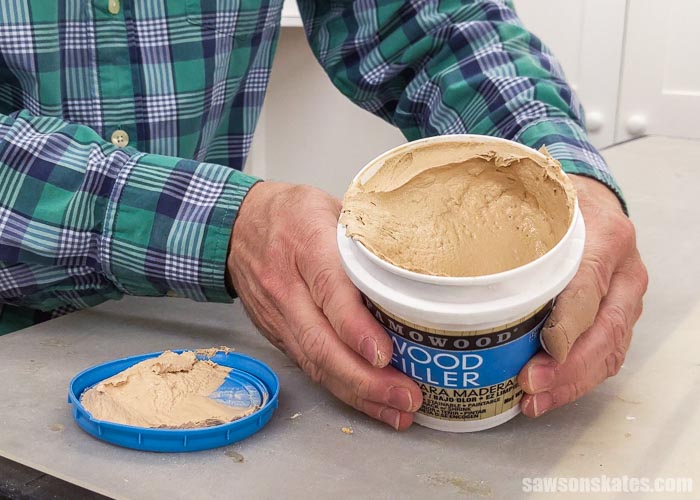
Hard vs Pliable
Wood filler dries quickly, usually in an hour or two, and hardens as it dries. On the other hand, Wood putty dries slowly and does not harden. Instead, when wood putty remains pliable when it’s completely dry.
The long drying times of wood putty can be a problem because it allows dust and dirt to accumulate while it dries.
Interior vs Exterior
Wood putty can be used indoors or outdoors, but it’s a great choice for exterior repairs because it remains pliable, so it expands and contracts with changes in temperature and humidity. It also acts as a sealant and is resistant to the effects of the sun and rain.
Wood filler is best suited for interior repairs. It’s not a good choice for outdoor projects because it dries hard, so it won’t expand and contract along with wood movement caused by seasonal changes. Instead, it could crack or break. It’s also not weatherproof, and sunlight can cause it to shrink and fall out.
Finished vs Unfinished
Because wood putty contains chemicals that can damage raw wood, it should only be used to repair imperfections in projects that have already been stained and top coated with a finish such as polyurethane.
Wood filler is best for repairs on unfinished wood before a stain or finish has been applied. The filler is applied, sanded, and then stained along with the wood.
Wood Filler vs Putty Comparison Chart
| Filler | Putty | |
| Consistency | Paste-like, dries hard | Clay-like, remains pliable |
| Where to Use | Indoors | Outdoors or indoors |
| When to Use | On raw wood | On finished wood |
| Color | Usually neutral | Wood tones |
| Structural Repairs | Yes | No |
Should I Buy Wood Filler or Wood Putty?
Now that we’ve looked at the key differences between wood filler and wood putty let’s summarize when you should use each one.
Generally, wood filler is best for repairing defects in unfinished wood, while putty is better suited for finished surfaces.
Filler dries hard and works best for indoor projects. Putty remains pliable and can be used indoors or outdoors, but it’s the best choice for outdoor projects.
Frequently Asked Questions
Is wood filler or wood putty better?
The answer to this question depends on the project you’re working on. If you’re repairing defects in unfinished wood, wood filler is a better choice because it can be sanded and stained to match your project. If you’re repairing defects in finished wood, wood putty is a better choice.
Can I use putty instead of wood filler?
No, you should not use putty instead of wood filler. While they’re both used to repair wood, filler is designed for use on unfinished surfaces. Putty contains chemicals that can damage raw wood and should only be used on stained or finished surfaces.
Does wood putty get as hard as the wood?
No, wood putty does not get as hard as wood. Once it dries, wood putty remains pliable.
Can you stain wood putty?
No, wood putty cannot be stained because it’s not porous like wood filler, so the stain will not penetrate it. The best option is to use a pre-tinted putty that matches the color of your stain.
Final Thoughts
When you’re ready to tackle a home improvement project, it’s important to know the difference between wood putty and wood filler. The two materials are similar in some ways but distinctly different in others.
By understanding how each of them works, when you should use them, and what their limitations are, your next DIY project will go smoothly without any surprises along the way!
Thank you for stopping by. If you enjoyed this tutorial, would you please take a moment and pin it to Pinterest? I’d really appreciate it!


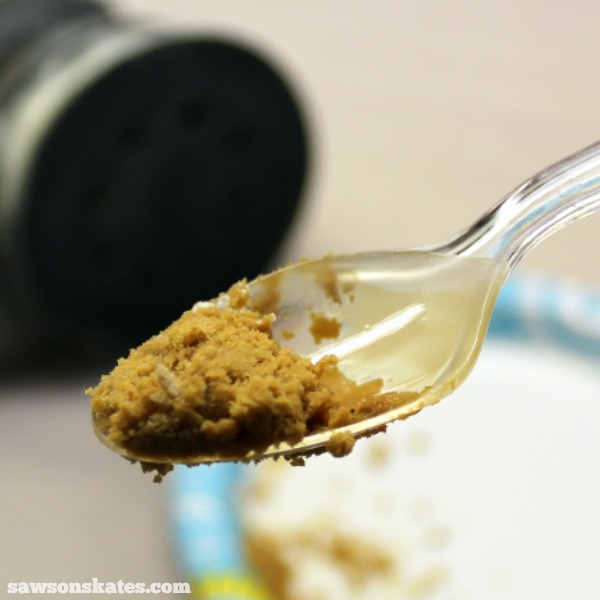
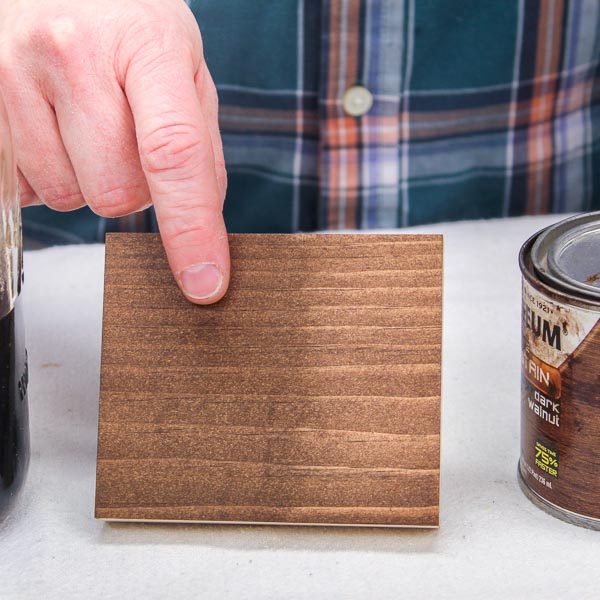
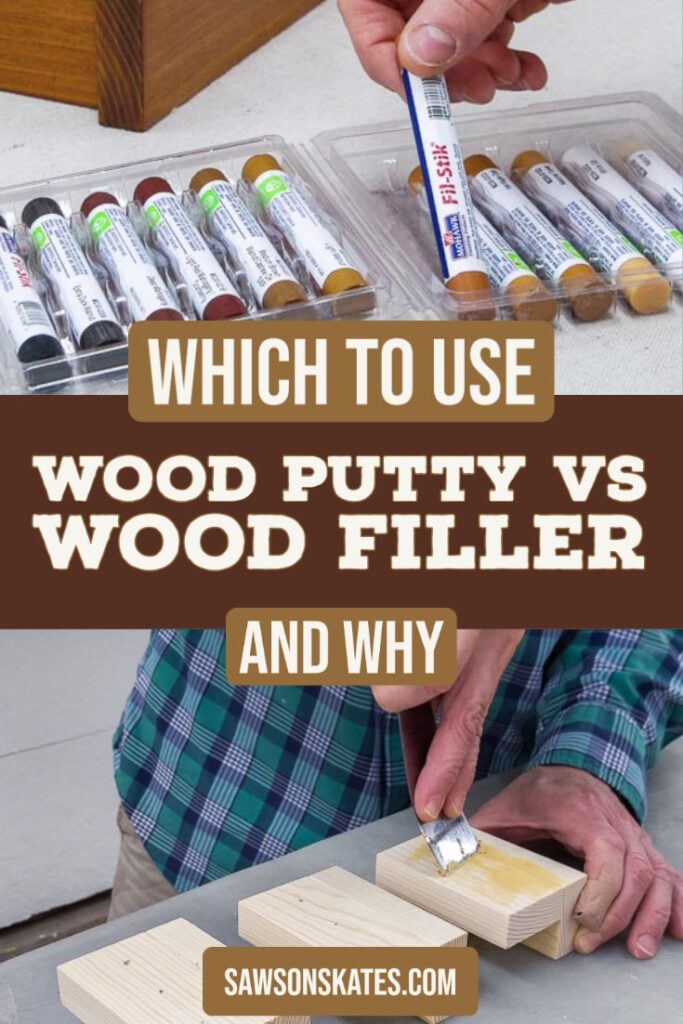
Good column! What I am curious about is DIY filler. By this I mean taking saw dust from your project and combining it with wood glue for filler? Doesn’t that also make it stainable?
Hi Guy – Thank you for the compliments. I tested seven stainable wood fillers, including sawdust mixed with glue, and shared the results in this article. Spoiler alert: glue mixed with sawdust was one of my least favorite options.